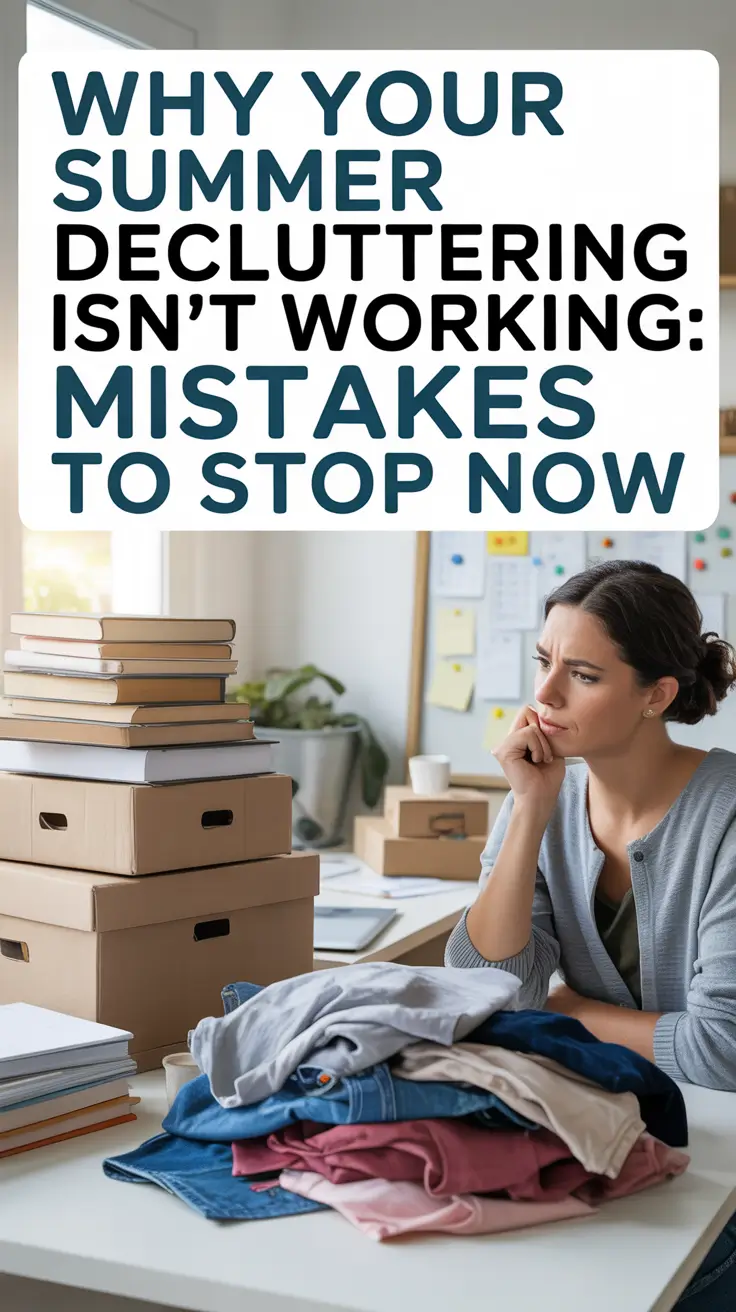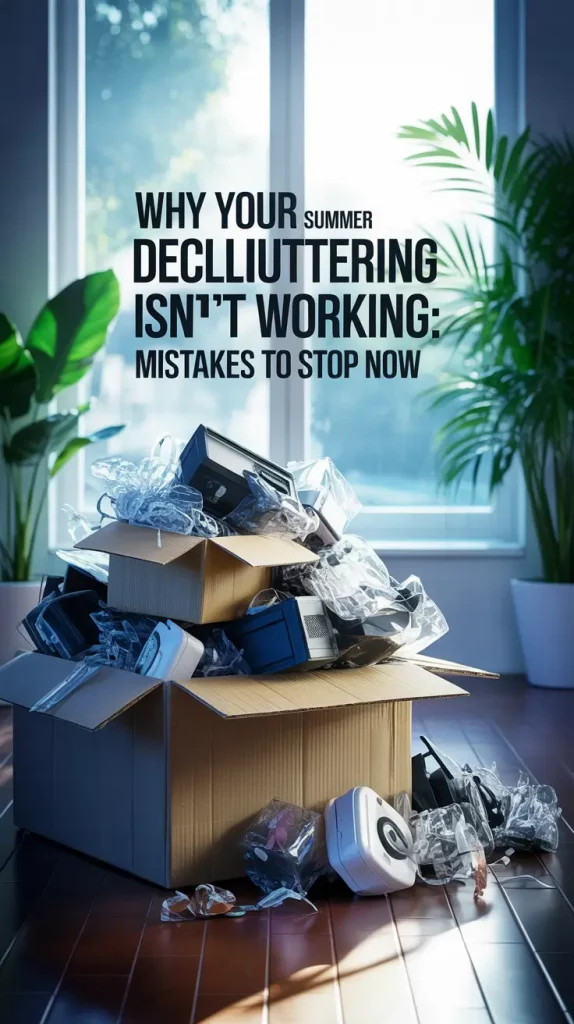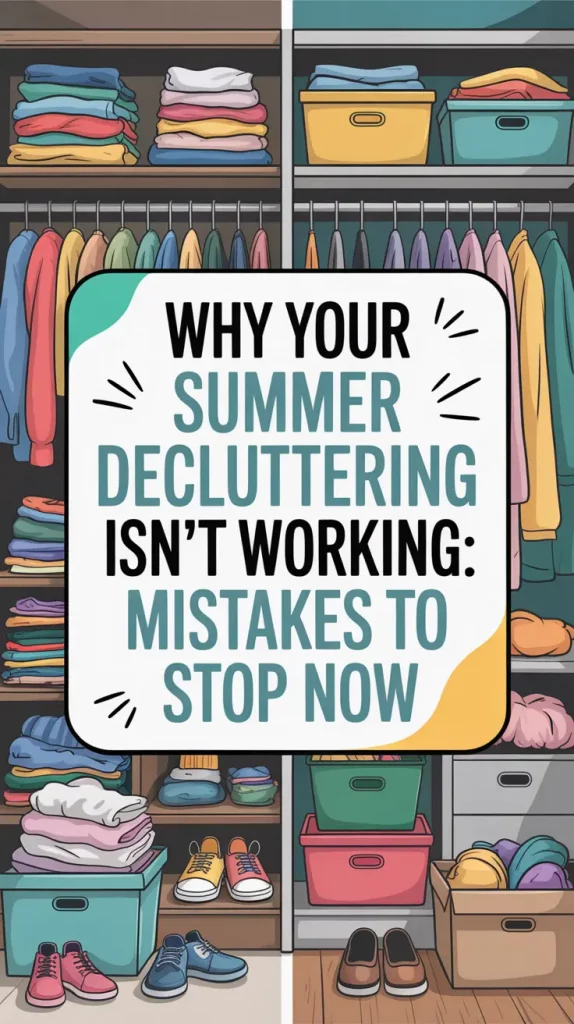Why Your Summer Decluttering Isn’t Working: Mistakes to Stop Now

It’s the summer and you want to declutter. You want to feel light, refreshed and in control but what if you’ve sorted everything and your home still feels chaotic. It just doesn’t make sense.
Simple household tasks like cleaning the house does not require any mental exertion. In reality, no amount of washing and cleaning suffices. Nothing feels good, and your home never stops feeling cluttered. In this blog, we delve into the reasons your summertime decluttering efforts always seem to fall flat, and how you can finally shift the narrative.
Target Audience
- Overwhelmed working professionals stuck in a never ending cycle of clutter
- Parents overwhelmed by the sheer volume of toys and seasonal mess
- Small apartment dwellers seeking more efficient use of space
- Anyone who feels like their ‘cleansing’ never quite achieves the intended effect
Link Between Emotions and the Summer Season for Declutter
Everyone wishes for a new start in during the summer. The warm days, longer hours and sunny weather tips us off to needing a seasonal change. This jolly season sets a cheerful image in people’s minds and they expect their houses to mirror the surroundings are light, breezy, and open. The holidays are meant to share that much awaited tranquil space but unfortunately end up disappointing.
Why Organization is More Than Just Cleaning
To declutter means to opt out of putting things in their rightful places. This action requires a decision-making process. It means letting go- of emotional baggage, fatigue, and attachment. Surrendering needless conflicts take the decision-making process hostage.
Have you experienced the frustration of organizing everything only to have the mess come back within weeks?
The 5 Decluttering Errors That Can Overcomplicate Your Efforts Over the Summer
Let’s explore five common decluttering mistakes that can quietly sabotage your summer organizing efforts—and how to fix them with clarity and intention.
We Make Things Worse By Only Shifting Them Around Without Organizing: Mistake #1
Decluttering isn’t about binning objects or stacking piles in closets. You either need to systematically get rid of everything or resort to reorganizing clutter, not decluttering. Letting go of things is very liberating, especially over the summer, when you don’t feel hoisted down by unnecessary burdens of restricted- fitting or- non-joy- branded items.
Mistake #2: Not Understanding What Triggers The Clutter
Guilt is a huge contributor. Do you keep things like gifts that you never liked, clothes that no longer fit, or boxes full of why not, just in case- items? We tend to hold on to things that have no emotion attached in regret. Guilt leads to creating a mental block that leads to not letting go of freedom granting-and- clutter freeing pieces.
Reflect: Would I buy this again today? If the answer isn’t “yes”, why is it still taking up space in my area?
Mistake #3: Underestimating the Time Needed to Declutter
There is too much focus on trying to complete every task at once, which results in you not completing anything. When trying to do decluttering in excess, people end up leaving most of the items because their brain shuts down. This creates an environment where everything is semi cluttered without any sense of order.
It is better to try and break the decluttering into small sections. Aim for 15 to 30 minute daily intervals.
Mistake #4: Not Figuring Out What is Essential
This mistake generally happens when there is a distribution of too many focus areas. You can pick “someday” placed, self-defining ambiguous items, or items left for when certain conditions are met, like “the guitar I’ve never tried”, or “the jeans I’m going to wear at some point, they will fit.”
You can use this one sentence test: Is there a reason I wouldn’t pick for these items for replacement immediately? If yes, keep them.
Mistake #5: No Consideration in Place After the Decluttering Stage
Individuals often come across these piles after portions have passed: keep, donate, and toss sections that have been worked on. Brought a myriad of “donate” bags that sit instead of being processed or taken to a further usable area? The task hasn’t been executed properly.
You need to have a plan: how do you propose removing from space or emptying your home of functional belongings.
Common Decluttering Mistakes and Fixes.
| Mistake | Why It Happens | How to Fix It |
|---|---|---|
| Just moving things | Fear of letting go | Commit to removing items entirely |
| Emotional attachment | Guilt, nostalgia | Use 3-question rule for each item |
| Overambitious timeline | Burnout | 15-minute micro-sessions daily |
| No criteria | Decision fatigue | Try the “replace today?” test |
| No post-plan | Procrastination | Schedule drop-offs, pickups immediately |
Data-Driven Decluttering In 2025: Step By Step Guide
Want to declutter and take charge of your space? Here is an effortless plan for the summer.
Step 1: Micro-Zone Decluttering
Choose single unit of space: a single drawer or shelf and concentrate on this unit for fifteen minutes. It adds up over time, and we might add, further fuels your motivation.
Step 2: Pose the Right Questions
It’s time to stop hoarding items that no longer hold sentimental value. Before keeping an item, ensure to double check;
- Have I actually used it (in the last 12 months)?
- Would I buy this again today?
- Regardless of my past, does this fit who I am right now?
Step 3: The Four Box Method
Label boxes or bags;
- Keep
- Donate
- Trash
- Relocate (this item belongs in a different room)
Decisions should be made for every single item, so the clutter won’t get displaced.
Step 4: Turn It Into Art
Take the “after” images of every decluttered section alongside the “before” images. Noting progress provides motivation.
Insights from Decluttering Authorities
As organized by The Home Edit, experts like Dana K. White believe the paradigm shift in decluttering rests on habit formation. It is not about annual decluttering sessions, rather weekly ones.
“If you can’t manage it in the space you have, you either need less stuff or more limits.” – Dana K. White
- Stick with the “one-in, one-out” policy
- Focus on hiding spaces
- Refrain from buying excess organizers pre-decluttering
Decluttering Trends in 2025
2025 will see decluttering move into the online world. Cleaning out your closet won’t be the only perimeter in focus, with many joining:
- Digital Declutter Challenges (organizing photos, files, emails)
- 30-Day Minimalism Marathons on Instagram
- Decluttering apps that gamify the process
The idea of “seasonal rotation” for clothing is regaining popularity, with bins used for monthly tiered access to reduce overwhelm.
The Key to Maintaining a Clutter-Free Lifestyle
Many people experience a sense of freedom when decluttering their spaces, especially during the summer. But how do you maintain that feeling?
- 3-Minute Rule: Do it now if putting something away takes three minutes or less.
- Visual Reset: Every Sunday, take a quick snapshot of each area to monitor for any accumulating clutter.
- Monthly Mini-Purges: Spend 30 minutes a month addressing more cluttered areas.
Final Thoughts: Why Your Featured Summer Decluttering Will Finally Work
There are some recap notes:
- Removing clutter fails when we treat it the same way we treat cleaning.
- Emotional clutter is the hardest to identify.
- We rely on micro-steps over mega-cleanouts.
- A system is necessary to do it repeatedly rather than just once.
- Integrating new habits while doing something leads to long-term success.
So… what did you put off donating?
Drop a comment on your summer decluttering wins and challenges. Be sure to share this guide with a friend who might need it!







